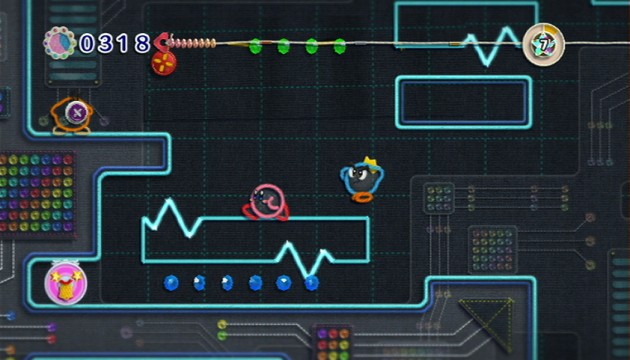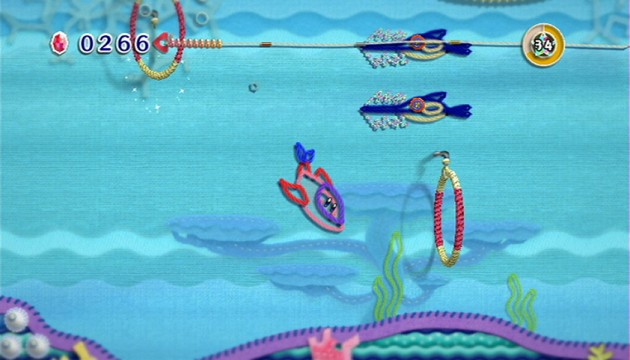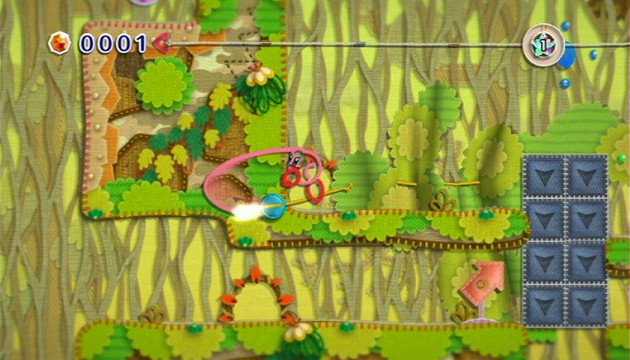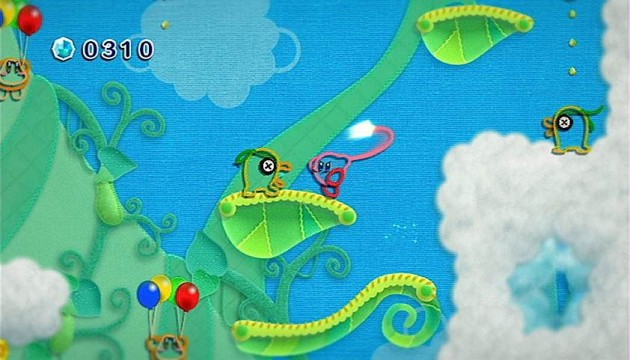Aesthetic and functional design, boundless creativity, fantastic soundtrack
Underdeveloped and boring apartment decorating, occasionally iffy controls
Kirby has always been a recognizable mascot in Nintendo’s stable of characters, but there has often been something holding back the console titles in his franchise– it’s too short (Kirby 64), it’s too much like previous Kirby games (Dream Land 3), it’s a weird spin-off (Air Ride), or it’s too easy (nearly any game; though in Kirby’s defense, the series was always intended to be “for beginners”). This is before you get into the drama that surrounded who was or was not involved in the games’ development or political struggles that resulted in delays and near-cancellations.
Kirby’s Epic Yarn might have followed the same path as its predecessors. The game was not originally designed as a Kirby title; instead it was going to star a new, original character, Prince Fluff. After many months in development and fear of cancellation over lack of inspiration, Nintendo tossed a potential bomb to developers Good-Feel: drop Prince Fluff and make it a Kirby game instead.
In spite of this daunting and potentially discouraging request, Good-Feel gained renewed inspiration, partnered up with original Kirby developers HAL Laboratory, and has created the first truly triple-A Kirby console title, and potentially the best the series has seen. And to the benefit and delight of cooperative gamers everywhere, not to mention Good-Feel, Prince Fluff stayed in the game as a playable character whenever a second player wants to jump into the experience. The cooperative gameplay isn’t pure drop-in/drop-out: at the start of each level you select whether you’ll play it with one or two players. Yet unlike the “girlfriend/little kid” cooperative gameplay featured in the Super Mario Galaxy games, player two’s Fluff is as fully functional and capable as Kirby.

This is also no typical Kirby game. The evil wizard Yin-Yarn is skulking around Kirby’s Dream Land world, and Kirby mistakenly spies Yin-Yarn’s “metamato” as a traditional “maxim tomato.” Since tomatoes are Kirby’s favorite food, he decides to inhale it, even after seeing it’s not a regular tomato and belongs to someone else (puckish, that Kirby is). Enraged, Yin-Yarn sucks Kirby into a magical sock hanging from the wizard’s necklace, and next thing Kirby is no longer in Dream Land, but Patch Land– a world made of yarn, buttons, felt and nearly any other soft-and-fuzzy crafting supply you could find at a craft supply store. And not only is the environment completely arts-and-crafts, but so too are its inhabitants and now Kirby himself. Stripped of his trademark inhale-and-steal-powers ability (a hollow yarn shape doesn’t inhale, apparently), Kirby’s still powerful: thanks to that metamato he engorged, he can instantly transform into a variety of objects and vehicles, the most exciting of which are at pre-determined spots in the main story’s 50 platforming levels.
Kirby and Fluff are controlled with the Wii remote held sideways, and only for a few vehicular transformations are tilting or pointing of the remote needed. Otherwise, the controls are simple and elegantly designed, if not always flawless. There are definitely times when you’ll fumble trying to trigger Kirby’s dash (double-tap and hold the D-pad in one direction) and he may repeatedly not fling his yarn whip the direction you intend– honestly, extra buttons or analog control would have addressed this but it’s expectedly kept simple.

Kirby’s transformations move the game experience in exciting ways, making even the most mundane actions (jumping, ground pounding, dashing and swimming) something magical as all have some kind of cleverly animated transformation of part or all of Kirby’s body (his feet become springs; his body becomes a weight, a car or submarine). Details such as this are unnecessary but separate the title from less fortunate games that have been rushed through a “get ‘er done” development cycle.
The vehicular transformations are even more thrilling and all the more special as they frequently only cover small sequences within large levels. They all bring a twist to the gameplay– the surfing penguin can use his spin as a double jump or attack; the mole can scale vertical surfaces; the fire truck can tilt its hose (via tilting the remote) to extinguish flying foes or knock down out-of-reach gems; the giant tank can briefly hover with rocket blasters and its missiles can be aimed with remote tilting as well. In two-player cooperative, vehicles’ functions are often split between the two players– such as with the tank, one person drives while the other fires missiles; figuring out what to do is part of the fun.
The only stumble in the many vehicles is when Good-Feel tries to rekindle the magic of Kirby Canvas Curse in the train mode. The train steadily moves forward and the player can only switch its direction. Meanwhile, you have to use the remote pointer to literally draw the tracks on screen, which often end up shaky and erratic at best, unless you’ve got a surgeon’s hands. Yet anything that takes Kirby flying in space vehicles– a UFO that can vacuum up gems and enemies, or spaceships and rockets that blast through Galaga and R-Type-esque levels– really makes Epic Yarn soar and cause you to hanker for even more of those experiences.

Typical of most platforming games, Prince Fluff’s Patch Land is split into seven regions: castle grounds, grassy fields, volcanic desert, beach and ocean, arctic mountains, toys and candy, and a futuristic sci-fi city. After the tutorial castle grounds, where Kirby goes through a starting level and is given an apartment he can furnish with furniture cut outs, fabric swatches and wallpaper (completely boring), Kirby must progress linearly through five levels and one boss battle in the six subsequent worlds. Two bonus levels are unlockable in each world as well, provided Kirby earns enough beads in the boss battle. From beginning to end the level designs are seldom ruthless but a gentle learning curve ensures the final stages and bosses will take some practice and determination.
Fortunately, Kirby (and Prince Fluff) can’t die in this game. Falling into a pit or getting touched by an enemy or bullet will cause the hero to drop a number of plastic and glass beads he’s collected while going through the level. These beads introduce the hardcore motivation for seasoned gamers: they’re easy to collect, but in order to earn the bronze, silver and gold medals in each level, the gamer can’t get hit too many times. Fortunately, unless the dropped beads fall down a pit, they’re easy to quickly recollect, and novice gamers without a bead left will still be able to continue and never have to restart a level for lack of beads.
In addition to beads, there are two pieces of apartment furniture and one soundtrack CD to collect in every platforming level. They’re seldom hard to find and usually only missed initially in racing levels where you have to learn about a location as you pass it. Back at the castle grounds, beads can be cashed into build out the apartment complex, furnish Kirby’s place and place key pieces of furniture in five other apartments to unlock minigames.
Yes, in addition to the lengthy single player campaign, there are scores of minigames to unlock and play in five different categories such as defeat all the enemies, snag a set number of beads, carry an object through an obstacle course– all within set periods of time. These minigames are staged within small chunks of previously-completed levels from the single player campaign, but in spite of their visual familiarity they are addictively fun and a great change of pace when you want a break from the story.

Tying Epic Yarn together, no pun intended, are the materials used to craft the world of Patch Land. Much as you may have experienced wonder at the ceaseless creativity in the Super Mario Galaxy games, you’re likely to be just as frequently surprised and impressed with how many staples of video game design have been reborn and revisited in textile material. Whether falling icicles, surging electrical currents, dust devils or jiggling mounds of gelatin, Good-Feel’s whimsical imagination is in top form. Plus, the cleverness of visual design doesn’t end on the superficial level– zippers and buttons can be tugged to reveal hidden areas or scrunch together previously uncrossable chasms. No matter if an enemy’s being unraveled, or you’re watching a grand, amusing animation on the world map for every single level’s introduction, you’ll never get bored. In fact, Good-Feel does more– much more– with its crafting materials than Nintendo’s first party teams have ever done with paper in the Paper Mario series.
If all of the above is not enough to sell the game, I’d be hugely remiss to not acknowledge the absolutely splendid soundtrack. In brief, it’s a mellow, jazz-pop affair that’s partially Charlie Brown and New Age in feeling– heavily piano-based, but also embellished with guitar, brass, strings, bells and synthesizer. Even in comparison to other meditative games like Endless Ocean, Epic Yarn has a strikingly unique and warm soundtrack that’s all its own. Interestingly, in spite of the lighthearted nature of Kirby and the game’s story, there are many songs that have an emotional complexity and depth to them that are unexpected, yet all the more impacting. Due to this, you’re likely to feel driven to collect all the soundtrack CDs in the game and relisten to your favorites in the bare-bones jukebox because the songs are just that good.
While participating in an Iwata Asks interview about Epic Yarn‘s development, the HAL Laboratory team made a point of stating it was working on a Kirby game of its own that we should look forward to. There’s no doubt anyone who plays Epic Yarn will look forward to another Kirby adventure, but the bar has been set very high by Good-Feel. Certainly, GoldenEye 007 and Donkey Kong Country Returns are likely to be on many peoples’ holiday wish lists this year, but Kirby’s Epic Yarn unequivocally deserves a spot on those lists, too. With its ceaselessly imaginative visuals, beautifully atypical soundtrack, and addictive and creative gameplay for new and seasoned gamers (both solo and paired up!), this is another must-buy title for Wii.
Nintendojo was provided a copy of this game for review by a third party, though that does not affect our recommendation. For every review, Nintendojo uses a standard criteria.




 ShareThis
ShareThis






Fantastic review. This game is a lot of fun. I’m really impressed with what Good-Feel’s done, and I hope Nintendo continues to work with them.
Can’t wait to play what seems like a gem of a game. Kirby’s Dream Land was one of the first video games I ever owned– certainly the first one I ever beat –and I’ve loved the little guy ever since.
I’ve had my eye on this ever since E3 but you’ve completely sold it for me. It looks adorable and seems perfectly aimed at my style of stress free gaming. I loved Power Paintbrush (Canvas Curse) but I don’t care what anyone says about Kirby games being easy, that was hard.